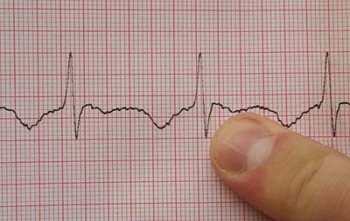
Cardiac Rhythm Mastery: ECG Interpretation for Nurses
This course is designed for nurse clinicians and bedside nurses utilizing telemetry who wish to advance their knowledge and skills in cardiac monitoring and rhythm interpretation. The purpose of this course is to equip nurses with the ability to accurately interpret electrocardiograms (ECGs) and identify both normal and abnormal cardiac rhythms.
Throughout the course, nurse learners will gain an in-depth understanding of cardiac anatomy and physiology, with a particular focus on the electrical conduction system of the heart. Participants will learn how the cardiac cycle correlates with ECG waveforms and how to interpret the normal and abnormal components of an ECG, including key measurements such as the PR interval, QRS duration, and T wave characteristics.
The curriculum emphasizes a systematic approach to rhythm analysis, enabling nurses to confidently assess, recognize, and respond to a variety of sinus, atrial, and ventricular rhythms. In addition to theoretical knowledge, the course includes practical applications, such as lead placement, use of five-step ECG interpretation, and evaluation of real-world rhythm strips.
Questions? Check out our FAQs page and How Online IV Certification Works!
Objectives
Upon completion of this course, participants will be able to:
- Describing cardiac anatomy and physiology as it relates to the electrical conduction in the heart.
- Compare how the cardiac waveform relates to what is occurring in the cardiac cycle.
- Identify normal components of the ECG and their measurements.
- Recognize abnormal components of the ECG and their measurements.
- Interpret basic rhythms, including normal sinus rhythm, sinus tachycardia, and sinus bradycardia.
- Recall correct 5-lead ECG electrode placement.
- State some of the causes and risk factors for the different rhythms.
Curriculum
Chapter 1: Introduction
- Cardiac Anatomy
- Electrical Conduction System
- Putting It All Together: The Cardiac Cycle
- Electrical vs. Mechanical Events Review
Chapter 2: Review of ECG Rhythm Strips
- Lead Placement and ECG Basics
- Five-step Approach to Reading an ECG
- Step 1: Assess Heart Rate
- Step 2: Assess Heart Rhythm
- Step 3: Assess for a P Wave
- Step 4: Assess the PR Interval
- Step 5: QRS Complex
Chapter 3: Sinus Rhythms
- Normal Sinus Rhythm
- Sinus Tachycardia
- Sinus Bradycardia
Chapter 4: Atrial Rhythms
- PACs
- Atrial Flutter
- Atrial Fibrillation
- SVT
Chapter 5: Ventricular Rhythms
- PVCs
- Ventricular Tachycardia
- Ventricular Fibrillation
Chapter 6: Conclusion and Scenarios
-
Case Scenarios
Chapter 7: References
- References
- California BON Required Implicit Bias Information
Price: $24.00
Contact Hours: 2

Course Author

Kendall Moore
Kendall is a 2022 Magna Cum Laude graduate from Tyler Junior College with an Associate Degree in Nursing. She has a deep passion for nutrition and hormone health, is a member of the American Holistic Nurses Association, and is currently enrolled in Pacific College's RN-to-BSN in Holistic Nursing program. Upon graduation, Kendall intends to begin a Nutritional Therapy Practitioner program to further expand her expertise.
In addition to her academic and professional pursuits, Kendall serves as the Chief Operating Officer of Pedagogy, where she manages the day-to-day operations of the company while simultaneously attending school and authoring educational courses. Her unique blend of leadership, clinical knowledge, and dedication to holistic health reflects her commitment to advancing both patient care and healthcare education.
Read Full BioCourse Accreditation
See our Accreditation Statements page to view our accreditation information.